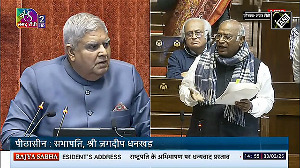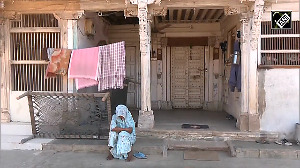Khalid Sheikh Mohammad is being projected by US officials and the army of so-called non-governmental counter-terrorism experts, who have sprung up since 9/11, as if he is the Field Marshal Montgomery or General Patton or General Rommel of Al Qaeda, but his case is getting curiouser and curiouser. Just like the earlier case about the kidnapping and murder of US journalist Daniel Pearl.
Remember the Pearl case? Pakistan's Inter-Services Intelligence claimed to have solved the case without recovering the dead body and prosecuted Sheikh Omar and his accomplices. The court was told they were the only plotters who deserved to be convicted and sentenced to death.
Even as the trial was mid-way, Pakistani security agencies, while investigating another case, fell upon a group of some other terrorists belonging to the Lashkar-e-Jhangvi and the Harkat-ul-Mujahideen (International). During the interrogation, they surprised Pakistani and US intelligence agencies by claiming it was they who had killed Pearl. They led the police to a spot on the outskirts of Karachi where Pearl's remains were found buried. Forensic tests confirmed their finding and the remains were subsequently handed over to his widow.
Under the law, when a confession made by a suspect leads to some material recovery such as a murder weapon or a dead body, there is an automatic presumption that the entire confession is correct. So, if the Pakistani and US agencies had followed the due process of law, they should have withdrawn the case from court, re-investigated it and submitted a fresh charge-sheet.
They did nothing of the sort. Instead, they kept away information about the recovery of Pearl's remains and the arrests of the new suspects from the court. When the defence counsel for Sheikh Omar asked the court to take cognisance of media reports in this regard and order a re-investigation, the court declined to do so. It sentenced Sheikh Omar to death and the other accused to life imprisonment. Their appeals have not been disposed off because Pakistani officials have not yet sorted out the confusion created by the recovery of Pearl's remains on information provided by some terrorists who had not been prosecuted in the case.
On March 1, 2003, a joint team of the ISI and US intelligence raided a house in Rawalpindi in an area where many retired officers of the Pakistan army and the ISI live and arrested three people, one of them a Pakistani. One of the arrested men was identified as Khalid Sheikh Mohammad and he was handed over to US intelligence officials, who flew him out to the US naval base on Diego Garcia, where a secret detention centre has been functioning since March 2002, away from the prying eyes of the media and international human rights organisations.
US officials and the Arthur Koestlers of the war on terrorism went to town with fanciful accounts of what a great catch it was, what a spectacular success for the US and Pakistani agencies etc. One ex-CIA official even claimed it was the greatest arrest ever made in the fight against terrorism since the second World War. Mohammad was made into a legend just as they had made Osama bin Laden into one after 9/11. They had earlier projected bin Laden as if he was one of those innumerable gods in Hindu mythology, with 10 heads, 20 arms and 20 legs, present anywhere and everywhere. Another similar god was created in the personage of Mohammad.
Even as this legend was filling up media space, the Pakistani authorities did a volte face within 24 hours and denied that Mohammad had been taken out of Pakistan. He was being interrogated in Pakistani territory by Pakistani officials, they maintained. Faisal Saleh Hayat, Pakistan's interior minister, even denied that the US had requested his extradition. He added that Mohammad would first be tried in Pakistan for offences before considering his extradition. Hayat confounded the confusion by saying since Mohammad is a Kuwaiti national, if at all he is extradited, he would be sent to Kuwait and not to the US.
Why this confusion? No credible answer is available. There is speculation galore in Pakistan, uncorroborated by evidence. Amongst the speculation are:
- When the Americans took Mohammad to Diego Garcia, they realised they had identified him incorrectly. They handed him back to the ISI and asked it to handle the mess as best as it can.
- An ISI official brought to the notice of his seniors that after the encounter in Karachi on September 11, 2002, in which Ramzi Binalshibh was captured, the officer in charge of the raid had submitted a report to the headquarters claiming to have killed Mohammad and buried his body without informing the Americans about it.
Sheikh Omar's defence counsel has drawn the attention of the appeals court to reports in the foreign media that it was Mohammad who masterminded Pearl's kidnapping and murder and pointed out that handing him over to the US without trying him in Pakistan vitiated the case against his client.
Pakistani officials have further tied themselves into knots by stating that Mohammad is in their custody. If so, his friends and relatives are entitled to move a writ of habeas corpus to produce him before a court. Officials of the Jamaat-e-Islami have already announced their intention to do so and the ISI has been trying frantically to pressurise them not to do so.
The Pakistani supreme court, while pronouncing judgment in a different case on March 3, 2003, has added to the confusion by ruling that Al Qaeda is not a terrorist organisation under Pakistani laws since the Musharraf government has not so far declared it to be so.
On August 14, 2001, Musharraf declared the Lashkar-e-Jhangvi and the Shia extremist Sipah Mohammad as terrorist organisations. On January 15, 2002, he added the Lashkar-e-Tayiba, the Jaish-e-Mohammad, the Sipah-e-Sahaba Pakistan, the Tehrik Jaffria Pakistan and an organisation active in the Federally Administered Tribal Areas to this list. But, till today, he has not declared Al Qaeda, the Taliban, the HUM and the Harkat-ul-Jihad-al-Islami as terrorist organisations. The supreme court has ruled that Al Qaeda could not be called a terrorist organisation in Pakistan till the government issued a notification under the Anti Terrorist Act of 1997 to declare it to be so.
What is happening in Pakistan would make a good case study of how not to wage a war on terrorism.






 © 2025
© 2025